A summary of how a Florida blacksmith and an Iowa University professor teamed up to solve the mystery of Damascus steel swords.
By: Verhoeven 12/2016
Damascus steel swords are often displayed in the Arms and Armor section of museums. The swords are famous because of their attractive surface patterns and their reputation originating in the crusades as being sharper and tougher than western swords. However, there was a mystery about how these swords were made because after around 1850 no one could make one.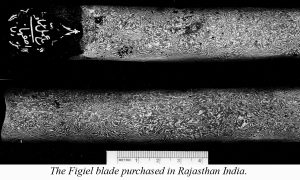
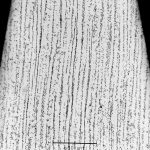
Shown at left is an 18-19th century Damascus blade piece donated to us by Leo Figiel. At the upper left is the Arabic inscription inlayed in gold identifying the maker. The as-received rusted blade was polished and etched on the right side of the inscription and also on the opposite face of the piece which is shown beneath the inscribed face. The picture illustrates the classic pattern on genuine Damascus blades. At the right is a transverse section from the end of the piece that was polished and etched to reveal the internal structure. A different etchant was used which inverts the contrast, the white carbides are now dark and the matrix steel (called pearlite) is now white. The aligned bands of small carbide particles produce the surface pattern where they intersect the blade surface. It was known that the blades were made from small ingots about the size of a hockey puck produced in India and called wootz steel by English observers who had witnessed how the blades were made in the early 1800s. The blades were made by simply forging the wootz cakes into blade shapes. The mystery was why did the resulting blades have such well aligned sheets of carbide particles.
C.S. Smith, the chief metallurgist in the Manhattan project, brought the mystery of these blades to the attention of the metallurgy community in a book published in 1960. He described what was known about the metallurgy of these swords and how they were made from small wootz steel ingots produced in India. In a paper published in 1963 on the history of metallurgy he describes Damascus steel knives as one of the four outstanding achievements in metallurgical history. In 1980 two metallurgists from Stanford, J. Wadsworth and O.D. Sherby published a recipe for producing blades which they claimed had solved the mystery. In 1983 C.S. Smith, in a letter to the editor in the journal Science, took issue with the Wadsworth-Sherby claim. I had been aware of the fascinating mystery of how Damascus steel swords were made. My interest was peaked when one of my students gave me a copy of a paper published by W. (Wally) M. Yater in the blacksmith magazine, Anvil’s Ring, 1983. Wally had done a thorough literature review of the information gathered mainly by English observers in the early 1800s of how the Wootz steel cakes had been made in India.
I thought that the secret might lie in a better understanding of how the small steel ingots solidified. I had been doing research on the solidification of metals for over a decade and came up with an hypothesis on how the surface patterns might form in these steel blades. I had solidification equipment in my lab and a graduate student, Larry Jones, also interested in this problem so we did some experiments to check out my hypothesis. Low carbon wrought steels (steels rolled or forged from the ingot material) cooled slowly from above a critical temperature called the A3 temperature were known to form a banded microstructure consisting of alternating sheets of pearlite and pure iron called ferrite. Like the carbide sheets the ferrite sheets etch white in the usual etchants thus producing the contrast with the dark etching pearlite. The structure was known since the early 1900s and was called ferrite/pearlite banding. The cause of the band formation had been widely studied and well established. When steel (which contains both carbon, C, and manganese, Mn, in the iron) solidifies the solidification front is not a flat planar surface of solid iron advancing into the liquid. Instead it consist of lined up needles of pure iron growing side by side into the liquid with the C and Mn atoms ejected in-between the needles. On cooling the final ingot slowly from above the A3 temperature the Mn that had segregated between the purer iron needle regions during solidifcation causes ferrite to form in one region and pearlite in the other and on mechanical reduction to the wrought form the two different regions line up into alternate bands.
My graduate student and I made up several small ingots and found a local young blacksmith, Howard Clark, to forge the ingots to blade shapes. Damascus steel contains significantly more carbon than low carbon steels that display ferrite/pearlite banding and do not form ferrite + pearlite on cooling but form pearlite + iron carbides. Similar to the A3 temperature for low carbon steels below which ferrite plus pearlite will form, high carbon steels have a critical temperature called Acm below which pearlite plus carbides form. If my hypothesis was correct slow cooling the forged high carbon steels slowly from above the Acm temperature should produce the aligned bands of carbides and the pearlite/carbide band structure of Damascus swords. However, slow cooling from above the Acm temperature produced a fairly random distribution of the carbides and no corresponding surface pattern, thus shooting down my hypothesis.
I thought perhaps the theory of Wadsworth and Sherby might be correct since we had proved my theory wrong. So Larry Jones and I made up ingots of pure iron and carbon with the carbon level in the known range of Damascus blades and heat treated them according to their recipe. Howard forged some of our ingots to blade shapes and we sent one of our ingots to Wally Yater and asked him to forge it to a blade shape. Wally had the ingots forged to a beautiful small blade by the famous American blacksmith Bill Moran. As with ingots forged by Howard, the Moran blade did not have the attractive surface pattern of Damascus blades and metallographic examination of the structure showed that the carbide particles did not have the correct alignment nor size or shape as in Damascus blades.
Wally described our work to fellow bladesmith from Florida, Al Pendray, at a blacksmith meeting and Al called me in 1988. After Al called me we realized that we got along well and both thought the Wadsworth-Sherby method was not the answer. Al had read their paper as well as C.S. Smith’s book and had been working on the problem for several years in his shop in Williston Fl. He had made literally hundreds of steel ingots in his home-made propane fired furnace and forged them to blade shapes. He even had an industrial sized forging hammer, a Nazel 3B pneumatic air hammer. He began to send me some of his blades and several of them had a good match for the internal microstructure and surface pattern of Damascus blades. But many did not and so we began a collaboration to see if we could figure out how to consistently make blades that matched both the internal microstructure and the surface patterns. Our work began in earnest when Al came to my lab in Ames, Iowa for 2 weeks in 1989.
At research universities like Iowa State professors are encouraged to do risky projects by being given funds to use at their own discretion. If the 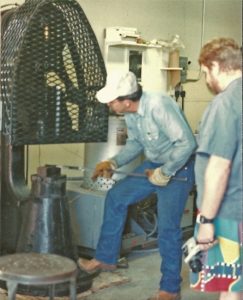 researcher is successful at obtaining grant money from outside agencies or industries a small fraction of those funds is put into a discretionary account that may be spent as he/she wishes. When we decided it would be a good idea for Al to visit my labs we had a problem in that the lab did not have a power forge hammer. Al seems to be a musician at obtaining good second hand equipment. He found us a power hammer called a Little Giant for $2000. I used my discretionary account to pay for it and Al arrived in Ames Iowa on a big flat bed truck run by a friend with the hammer and one of his small propane powered furnaces. The engineering college had found me a large empty lab room in one of their storage building about 5 miles from the campus and we set up out there with Al’s equipment along with salt pots, resistance furnaces and electronic equipment borrowed from my lab. We spent two weeks doing experiments with Al showing my grad students how to forge and charming us all with his southern drawl and numerous stories. We learned of his earlier success as a top ten rodeo performer and he learned some metallurgy ideas and how a metallography lab works and developed a close relationship with my colleague David Peterson who was interested in our project and later visited Al in Fl. The picture at the right shows Al working at the little giant hammer showing graduate student Gary Haupt how to forge. Interestingly, the young Iowa blacksmith, Howard Clark, visited almost daily during Al’s stay. Howard has gone on to become a famous Master Bladesmith producing Japanese Samurai swords just as beautiful and sharp as original Samurai swords but tougher- they show superior resistance to breaking.
researcher is successful at obtaining grant money from outside agencies or industries a small fraction of those funds is put into a discretionary account that may be spent as he/she wishes. When we decided it would be a good idea for Al to visit my labs we had a problem in that the lab did not have a power forge hammer. Al seems to be a musician at obtaining good second hand equipment. He found us a power hammer called a Little Giant for $2000. I used my discretionary account to pay for it and Al arrived in Ames Iowa on a big flat bed truck run by a friend with the hammer and one of his small propane powered furnaces. The engineering college had found me a large empty lab room in one of their storage building about 5 miles from the campus and we set up out there with Al’s equipment along with salt pots, resistance furnaces and electronic equipment borrowed from my lab. We spent two weeks doing experiments with Al showing my grad students how to forge and charming us all with his southern drawl and numerous stories. We learned of his earlier success as a top ten rodeo performer and he learned some metallurgy ideas and how a metallography lab works and developed a close relationship with my colleague David Peterson who was interested in our project and later visited Al in Fl. The picture at the right shows Al working at the little giant hammer showing graduate student Gary Haupt how to forge. Interestingly, the young Iowa blacksmith, Howard Clark, visited almost daily during Al’s stay. Howard has gone on to become a famous Master Bladesmith producing Japanese Samurai swords just as beautiful and sharp as original Samurai swords but tougher- they show superior resistance to breaking.
After Al left we continued close correspondence with him making blades and sending me samples to examine and test. My first visit to his shop in Williston, FL was in 1991. He had been successful in making three cakes that forged into blades with an excellent match to a Damascus blade. I brought along an infrared pyrometer from my lab at Iowa State and carefully calibrating it with an internal thermocouple during forging. We then measured the temperature variation during the forging cycle as Al forged the 3 ingots to blades of various thicknesses and later I evaluated the development of the internal microstructure in those stages in my metallography lab. I also brought two ingots from IA to further test the Wadsworth-Sherby method. Damascus steels were first analyzed in the 1920s and their chemical composition was well known. We had further analysis done on a few genuine Damascus blades which produced similar results. In addition to the iron and carbon the blades contain low levels of Mn, Sulfur, S, Phosphorous, P, and Silicon, Si. Our first experiment to test the Wadsworth-Sherby method had used only high purity iron plus carbon. So Al forged the new ingots containing the Mn, P, S, and Si additions into blades and examination of the them back in my lab gave the same negative results as our first experiments. A few months after we had analyzed these experiments we submitted a paper published in 1992 describing our technique for making a reproduced Damascus blade as well as the additional work not supporting the Wadsworth-Sherby method. Al made one of the successful ingots, coded 4191, into a small knife blade which is shown below. The surface pattern is a good match to many museum quality Damascus blades.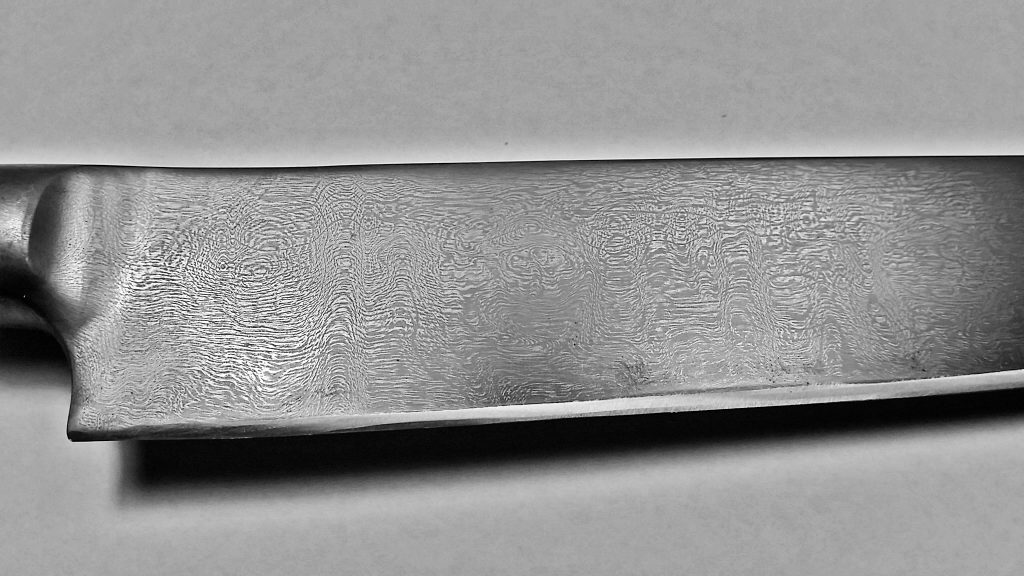
The micrograph at the right is a longitudinal section of the blade showing the aligned sheets of carbide particles that produce the sur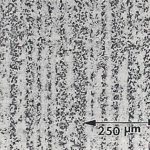 face pattern.
face pattern.
Al also used this ingot to make a blade piece having the famous Mohammed’s ladder pattern forged into it. The figure at the top of the next page shows the results where the arrows point to the rungs of the ladder pattern. High quality museum blades also sometimes have a rose pattern in them and Al successfully reproduced that pattern seen between the ladder rungs in this picture . Recently several smiths around the world claim they are making these Damascus reproductions but as far as we know no one has reproduced the ladder/rose pattern.
It was not until late 1995 that we determined that the secret of making Damascus steel blades was the presence of carbide forming elements, mainly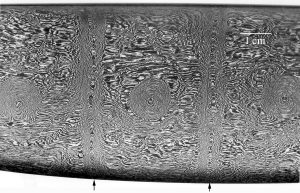 Vanadium, V, present at very low levels in the starting charge. Levels as low as 0.004 % V were found to be adequate. I was biased against the idea that an element present at such low levels could be the cause and therefore we did not pursue analysis of such low level “third” elements due to this blind spot. There were many other possible causes that might produce the banding and we spent the next 4 years chasing them down. We made small ingots following the methods used in the reports from India for the small wootz ingots made there in the 18-19th century, putting a tight lid on our crucibles and piling green leaves and broken up bottle glass on top of the irons. On heating the glass melts forming a slag that floats on top of the iron and in combination with the vaporized leaves keeps the iron from oxidizing and may remove impurities from it. Al had used a variety of irons for the charge mixing a high purity iron, called Armco iron with a low carbon steel called 1010 steel or with wrought iron and sometimes with a cast iron called Sorel iron. As mentioned above there were many “third” elements in original Damascus steels, particularly Mn, P, S, and Si, and I was hung up thinking one of these must by the secret. Particularly S or P as these two elements are what metallurgists call surface active elements and were known to cause large effects on mechanical properties of steel when present at very low levels. Was it one of the components making up the slag, was it something being extracted from the crucible walls, was it the type of iron used to make the charge, was it time or temperature used to heat the molten metal, was it the cooling rate when the metal solidified, etc. So we spent the next four years chasing down all these possibilities.
Vanadium, V, present at very low levels in the starting charge. Levels as low as 0.004 % V were found to be adequate. I was biased against the idea that an element present at such low levels could be the cause and therefore we did not pursue analysis of such low level “third” elements due to this blind spot. There were many other possible causes that might produce the banding and we spent the next 4 years chasing them down. We made small ingots following the methods used in the reports from India for the small wootz ingots made there in the 18-19th century, putting a tight lid on our crucibles and piling green leaves and broken up bottle glass on top of the irons. On heating the glass melts forming a slag that floats on top of the iron and in combination with the vaporized leaves keeps the iron from oxidizing and may remove impurities from it. Al had used a variety of irons for the charge mixing a high purity iron, called Armco iron with a low carbon steel called 1010 steel or with wrought iron and sometimes with a cast iron called Sorel iron. As mentioned above there were many “third” elements in original Damascus steels, particularly Mn, P, S, and Si, and I was hung up thinking one of these must by the secret. Particularly S or P as these two elements are what metallurgists call surface active elements and were known to cause large effects on mechanical properties of steel when present at very low levels. Was it one of the components making up the slag, was it something being extracted from the crucible walls, was it the type of iron used to make the charge, was it time or temperature used to heat the molten metal, was it the cooling rate when the metal solidified, etc. So we spent the next four years chasing down all these possibilities.
In order to separate out all the possible causes we needed to develop a procedure for consistently making steel cakes that would produce the correct 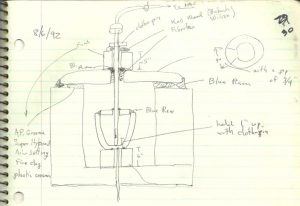 microstructures and surface patterns during forging. On my second visit to Fl in 1992 I brought along a chart recorder and we set up Al’s furnace arrangement with a thermocouple coming in through the lid protected by a ceramic tube as shown in the page copied from my data book at the right. This arrangement allowed us to measure the internal temperature and evaluate the temperature at which the melts began to freeze and to determine the temperature difference between the control thermocouple outside the bottom of the crucible and the melt temperature. In addition to hooking up the thermocouple output to the chart recorder I brought along a small computer which allowed us to collect the digital output into a computer file for additional analysis. We left the chart recorder with Al so that he would be more able to consistently reproduce his melt procedure from run to run. I also visited Al in 1993 with graduate student Paul Berge and we ran several additional melts. After another year or so Al made an important discovery. If he always used the starting charge material of Sorel iron plus Armco iron he could consistently make ingots that successfully patterned. Sorel iron is a high purity high carbon, around 4 % C, iron made from an ore deposit in Canada. It is used in iron foundries producing ductile cast iron. Al found out about it when visiting a nearby foundry and they had tons of it and were willing to part with the small amounts he needed. Unknown to us and fortuitously this iron also contained a small amount of V.
microstructures and surface patterns during forging. On my second visit to Fl in 1992 I brought along a chart recorder and we set up Al’s furnace arrangement with a thermocouple coming in through the lid protected by a ceramic tube as shown in the page copied from my data book at the right. This arrangement allowed us to measure the internal temperature and evaluate the temperature at which the melts began to freeze and to determine the temperature difference between the control thermocouple outside the bottom of the crucible and the melt temperature. In addition to hooking up the thermocouple output to the chart recorder I brought along a small computer which allowed us to collect the digital output into a computer file for additional analysis. We left the chart recorder with Al so that he would be more able to consistently reproduce his melt procedure from run to run. I also visited Al in 1993 with graduate student Paul Berge and we ran several additional melts. After another year or so Al made an important discovery. If he always used the starting charge material of Sorel iron plus Armco iron he could consistently make ingots that successfully patterned. Sorel iron is a high purity high carbon, around 4 % C, iron made from an ore deposit in Canada. It is used in iron foundries producing ductile cast iron. Al found out about it when visiting a nearby foundry and they had tons of it and were willing to part with the small amounts he needed. Unknown to us and fortuitously this iron also contained a small amount of V.
By the end of 1994 Al had successfully made 8 runs using a charge of the high purity Armco iron and the Sorel iron. All the ingots on forging to blades formed good patterns and showed the internal aligned sheets of clustered carbide particles. He also made 3 melts using only the Armco iron with carbon added by including some graphite and the internal carbides were randomly distributed with no surface patterns. We finally tumbled to the fact that there must be some chemical elements present at extremely low levels in the Sorel iron which produced the alignment. We then carried out an extensive set of chemical 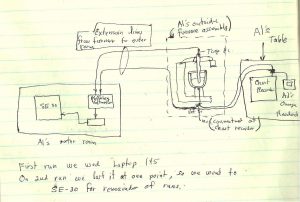 analyses using emission spectrograph analysis at Nucor steel and mass spectrometer analysis at the Ames Lab of Iowa State University. This latter technique is very sensitive to low levels of an element. We had hypothesized that carbide forming elements might enhance the formation of the aligned carbide particles and we found that three such carbide forming elements were higher in the good ingots, V, chromium, Cr, and titanium, Ti. So we had my lab make up small buttons of iron loaded with these 3 chemical elements and buttons loaded with S and P. I returned to Al’s shop in late 95 with my colleague Ed Gibson who was better with using electronic equipment and we setup Al’s shop for the critical experiments. Here is a page from my notebook showing how we set up Al’s shop for the experiments. We ran experiments with the Armco only, Armco and the button containing P and S and experiments with the Armco and the buttons containing the three carbide forming elements. No internal alignment of the carbides or surface patterns were found on the Armco only or Armco plus P and S. Excellent internal alignment of carbides and surface patterns were found on the several ingots we made with the added carbide element addition. These results are illustrated by the micrographs of the internal blade microstructures shown in Fig. 5 taken from our 1996 paper where we presented our results.
analyses using emission spectrograph analysis at Nucor steel and mass spectrometer analysis at the Ames Lab of Iowa State University. This latter technique is very sensitive to low levels of an element. We had hypothesized that carbide forming elements might enhance the formation of the aligned carbide particles and we found that three such carbide forming elements were higher in the good ingots, V, chromium, Cr, and titanium, Ti. So we had my lab make up small buttons of iron loaded with these 3 chemical elements and buttons loaded with S and P. I returned to Al’s shop in late 95 with my colleague Ed Gibson who was better with using electronic equipment and we setup Al’s shop for the critical experiments. Here is a page from my notebook showing how we set up Al’s shop for the experiments. We ran experiments with the Armco only, Armco and the button containing P and S and experiments with the Armco and the buttons containing the three carbide forming elements. No internal alignment of the carbides or surface patterns were found on the Armco only or Armco plus P and S. Excellent internal alignment of carbides and surface patterns were found on the several ingots we made with the added carbide element addition. These results are illustrated by the micrographs of the internal blade microstructures shown in Fig. 5 taken from our 1996 paper where we presented our results.
Analysis of the Armco only ingots showed average values of Cr, V and Ti of 0.025, < 0.001 and 0.001 % respectively and 0.015, 0.0085 and 0.0011 in the carbide added ingots. This result gave strong evidence that it was probably the small amount of V that somehow produced the alignment of the carbides during the forging of the ingots to blade shapes. We celebrated.
In 1988 Bill Dauksch, a metallurgist who retired from Nucor steel at the vice president level, began visiting Al and offering advice. Bill began joining us when I 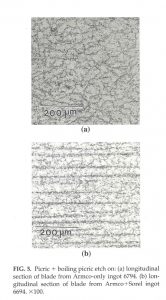 started visiting Al in 1991. He offered us important help in making suggestions and he was able to arrange for us to obtain emission spectrographic analysis of the ingots Al made up at Nucor which was critical for this work. He also arranged for me to make a presentation at Nucor on the project which resulted in Nucor giving us a small grant for expenses in our research. In 1993, Al, Bill and I went to Hagen Germany to present our work at a Damascus Steel Conference. On the way we stopped off in London and visited the Arms and Armor people at several museums there and I gave a seminar on our work at Imperial College in London. My presentation at the conference was well received. Europeans had been holding a conference on Damascus Steel every 5 years but after our presentation the conferences stopped, making us think we had convinced them we had found the method used to make these blades. While there we were approached by the director of the Arms and Armor division of the Bern Switzerland museum offering to give us small pieces of three genuine swords from their collection. We were delighted. The swords had been collected from India and Asia by a man who donated them to science for study in the 1920s. It is difficult to obtain samples of genuine Damascus steel swords that you can cut up for analysis as they are so valuable. Not only could we section and analyze these samples but they were pieces of a very famous study of Damascus steel by the French scientist B. Zschokke published in 1924. We found that all three swords from the Bern museum had low levels of V in them. In addition to the Figiel blade shown above we had two other pieces from genuine Damascus blades and these three blades also had low levels of V in them. It is not uncommon for iron ores to contain small amounts of V and these six blades must have been made using such ores. In 1998 we published a paper showing that all six blades contained low levels of V. Subsequent to this study we did a systematic study where we supplied Al with buttons doped with the carbide forming elements, V, Cr, Niobium, Nb and Molybdenum, Mo. We found that low levels of all of these elements produced alignment of the carbides during forging with V and Mo being most effective. Using electron probe microanalysis in an electron microscope we found that as expected the carbide forming elements segregated into the iron carbides. This would make it more difficult for these carbides to dissolve during the high temperature portions of the forging cycles. And since they had segregated into aligned arrays on freezing could lead to the aligned carbide arrays formed on forging Damascus steels, just as Mn functions in the pearlite/ferrite banding of low carbon steels. This idea is the basis of the hypothesis presented in our 1996 paper as to why such low levels of carbides can lead to alignment of the carbides on the repeated heat/cool cycles of forging. It is a type of pearlite/carbide banding similar to that of pearlite/ferrite banding in low carbon wrought steels only to make it occur one must heat and cool many times rather than just once. Such heating and cooling occurs automatically while forging the steel cakes into blade shapes.
started visiting Al in 1991. He offered us important help in making suggestions and he was able to arrange for us to obtain emission spectrographic analysis of the ingots Al made up at Nucor which was critical for this work. He also arranged for me to make a presentation at Nucor on the project which resulted in Nucor giving us a small grant for expenses in our research. In 1993, Al, Bill and I went to Hagen Germany to present our work at a Damascus Steel Conference. On the way we stopped off in London and visited the Arms and Armor people at several museums there and I gave a seminar on our work at Imperial College in London. My presentation at the conference was well received. Europeans had been holding a conference on Damascus Steel every 5 years but after our presentation the conferences stopped, making us think we had convinced them we had found the method used to make these blades. While there we were approached by the director of the Arms and Armor division of the Bern Switzerland museum offering to give us small pieces of three genuine swords from their collection. We were delighted. The swords had been collected from India and Asia by a man who donated them to science for study in the 1920s. It is difficult to obtain samples of genuine Damascus steel swords that you can cut up for analysis as they are so valuable. Not only could we section and analyze these samples but they were pieces of a very famous study of Damascus steel by the French scientist B. Zschokke published in 1924. We found that all three swords from the Bern museum had low levels of V in them. In addition to the Figiel blade shown above we had two other pieces from genuine Damascus blades and these three blades also had low levels of V in them. It is not uncommon for iron ores to contain small amounts of V and these six blades must have been made using such ores. In 1998 we published a paper showing that all six blades contained low levels of V. Subsequent to this study we did a systematic study where we supplied Al with buttons doped with the carbide forming elements, V, Cr, Niobium, Nb and Molybdenum, Mo. We found that low levels of all of these elements produced alignment of the carbides during forging with V and Mo being most effective. Using electron probe microanalysis in an electron microscope we found that as expected the carbide forming elements segregated into the iron carbides. This would make it more difficult for these carbides to dissolve during the high temperature portions of the forging cycles. And since they had segregated into aligned arrays on freezing could lead to the aligned carbide arrays formed on forging Damascus steels, just as Mn functions in the pearlite/ferrite banding of low carbon steels. This idea is the basis of the hypothesis presented in our 1996 paper as to why such low levels of carbides can lead to alignment of the carbides on the repeated heat/cool cycles of forging. It is a type of pearlite/carbide banding similar to that of pearlite/ferrite banding in low carbon wrought steels only to make it occur one must heat and cool many times rather than just once. Such heating and cooling occurs automatically while forging the steel cakes into blade shapes.
In Al’s initial efforts to produce a replica of Damascus blades he used a variety of starting irons, Armco iron, Sorel iron, 1010 steel and wrought iron. Going back and reviewing the starting materials used in blades which produced good patterns we found that most all of them had used Sorel iron. However, the ingot 4191 used to produce the nicely patterned blades shown above used only Armco iron and wrought iron. So we went back and analyzed this ingot material for low levels of carbide forming elements. It was found to contain 0.005 % V and 0.09 % Cr. These carbide forming elements must have been fortuitously present in the wrought iron, as was the V in Sorel iron. With chemical analyses we confirmed that the Sorel iron contained around 0.03 % V.
So, after roughly a decade long collaborative effort we were finally able to produce compelling evidence of how and why the patterns were formed by ancient smiths in Damascus steel swords.